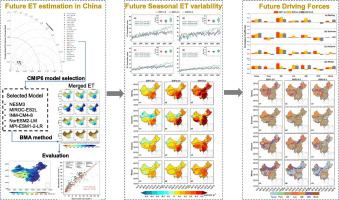当前位置:
X-MOL 学术
›
Sci. Total Environ.
›
论文详情
Our official English website, www.x-mol.net, welcomes your feedback! (Note: you will need to create a separate account there.)
The seasonal variability of future evapotranspiration over China during the 21st century
Science of the Total Environment ( IF 9.8 ) Pub Date : 2024-03-19 , DOI: 10.1016/j.scitotenv.2024.171816 Shan Lin , Xiangyang Sun , Kewei Huang , Chunlin Song , Juying Sun , Shouqin Sun , Genxu Wang , Zhaoyong Hu
Science of the Total Environment ( IF 9.8 ) Pub Date : 2024-03-19 , DOI: 10.1016/j.scitotenv.2024.171816 Shan Lin , Xiangyang Sun , Kewei Huang , Chunlin Song , Juying Sun , Shouqin Sun , Genxu Wang , Zhaoyong Hu

|
The evapotranspiration (ET) plays a crucial role in shaping regional climate patterns and serves as a vital indicator of ecosystem function. However, there remains a limited understanding of the seasonal variability of future ET over China and its correlation with environmental drivers. This study evaluated the skills of 27 models from the Six Phase of Coupled Model Intercomparison Project in modeling ET and the Bayesian Model Averaging (BMA) method was employed to merge monthly simulated ET based on the top five best-performing models. The seasonal changes in ET under three climate scenarios from 2030 to 2099 were analyzed based on the BMA-merged ET, which was well validated with observed ET collected from fourteen flux sites across China. Significant increasing ET over China are projected under all seasons during 2030–2099, with 0.05–0.13 mm yr, 0.11–0.23 mm yr, and 0.20–0.41 mm yr under SSP1–2.6, SSP2–4.5 and SSP5–8.5 scenarios, respectively. Relative to the historical period (1980–2014), the relative increase in ET over China is highest in winter and lowest in summer. Seasonal ET increases significantly in all seven climate sub-regions under high forcing scenario. Higher ET increase is generally found in southeastern humid regions, while lowest ET increase occurs in northwest China. At the country level, the primary factor driving ET increase during spring, summer, and autumn seasons is the increasing net radiation and warming. In contrast, ET increase during winter is influenced not only by energy factors but also by vegetation-related factors. Future seasonal ET increase is predominantly driven by increasing energy factors in the southeastern humid region and Tibetan Plateau, while seasonal ET changes in the northwest region prevailingly depend on soil moisture. Results indicate that China will experience a “wet season will get wetter, and dry season will become drier” in the 21st century with high radiation forcing scenario.
更新日期:2024-03-19



























 京公网安备 11010802027423号
京公网安备 11010802027423号